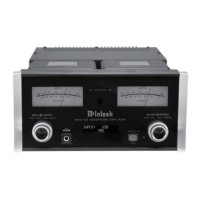10
Warning: Loudspeaker terminals are hazardous live and
present a risk of electric shock. For additional
instruction on making Loudspeaker Connec-
tions contact your McIntosh Dealer or McIn-
tosh Technical Support.
The McIntosh MHA100 Power Amplifier Circuitry is
designed for a single 8 ohms Loudspeaker connected
to the Right and Left Output Terminals.
The recommended cable size is shown below:
Cable Distance vs American Wire Gauge (Size)
Loudspeaker
Impedance
25 feet
(7.62 meters)
or less
50 feet
(15.24 meters)
or less
100 feet
(30.48 meters)
or less
8 Ohms
16AWG 14AWG 12AWG
1. Prepare the Loudspeaker Hookup Cable for attach-
ment to the MHA100:
Bare wire cable ends:
Carefully remove sufficient insulation from the
cable ends, refer to figures F, G & H. If the cable
is stranded, carefully twist the strands together
as tightly as possible.
Notes: 1. If desired, the twisted ends can be tinned
with solder to keep the strands together.
2. The prepared bare wire cable ends may be
inserted into spade lug connectors.
3. Banana plugs are for use in the United
States and Canada only.
%DQDQD3OXJVDUHIRUXVHLQWKH8QLWHG6WDWHVDQG
&DQDGDRQO\
2. Attach the previously prepared bare
wire cable ends into the banana plugs
and secure the connections. Refer to
figure I.
Connecting Components
The MHA100 has the ability to automatically switch
power On/Off to McIntosh Source Components via
the Power Control connection.
The connection instructions below, together with
the MHA100 Connection Diagram on the next page
is an example of a typical audio system. Your system
may vary from this, however the actual components
would be connected in a similar manner. For addition-
al information refer to “Connector and Cable Informa-
tion” on page 4.
Note: When the MHA100 is being added to an existing
Audio (or Audio/Video) System, please proceed to
page 12. If the MHA100 will be used with an exter-
nal Power Amplifier, please refer to page 13.
Power Control Connections:
1. Connect a Control Cable from the MHA100 PWR
&75/3RZHU&RQWURO287-DFNWRWKH3RZHU
Control In on the Tuner.
2. Connect a Control Cable from the Tuner Power
Control Out Jack to the Disc Player Power Control
In Jack.
3. Connect any additional McIntosh Components in
a similar manner, as outlined in steps 1 thru 2.
Audio Connections:
4. Connect the Audio Cable from the MHA100 UN-
BAL 1 L & R jacks to the Disc Player Fixed Audio
Output Jacks.
Note: The Balanced Input may be used instead of the
UNBAL Unbalanced Inputs.
5. Connect any additional Components in a similar
manner, as outlined in step 4.
Optional Digital Audio Connections:
6. Connect an Coaxial Cable from the MHA100
DIGITAL AUDIO INPUT COAX connector to the
Digital Audio Out Optical Connector on the Tuner.
Note: The OPTICAL Input (on the MHA100 and on the
Tuner) may be used instead of the Coaxial Con-
nections.
2SWLRQDO86%&RQQHFWLRQ
&RQQHFWD86%FDEOHZLWKW\SH$WRW\SH%FRQ-
nectors from the MHA100 USB Input to an avail-
able USB connector on a Computer.
Output Terminals
When connecting the Loudspeaker Hookup Cables to
the MHA100 Output Terminals please follow the steps
below:
1. Rotate the top of the Output Terminal Post coun-
terclockwise until an opening
DSSHDUV5HIHUWR¿JXUHV$DQG
B.
2. Insert the Loudspeaker hookup
cable into the Output Terminal
Post opening or the cable spade
lug around the center post of
the Output Terminal. Refer to
¿JXUH&
3. Rotate the top of the Output
Terminal Post clockwise until it
LV¿QJHUWLJKW5HIHUWR¿JXUH'
4. Place the supplied McIntosh
Wrench over the top of the Out-
put Terminal and rotate it one
TXDUWHURIDWXUQWRVHFXUH
the Loudspeaker Cable Connec-
tion. Do not over tighten. Refer
WR¿JXUH(
Figure A
Opening
Figure B
Figure C Figure D
Figure E
Caution: Do not connect the AC Power Cord to the
MHA100 Rear Panel until after the Loudspeak-
er Connections are made. Failure to observe
this could result in Electric Shock.
How to Connect Optional Loudspeakers
Figure F
Figure G
Figure H
Figure I

